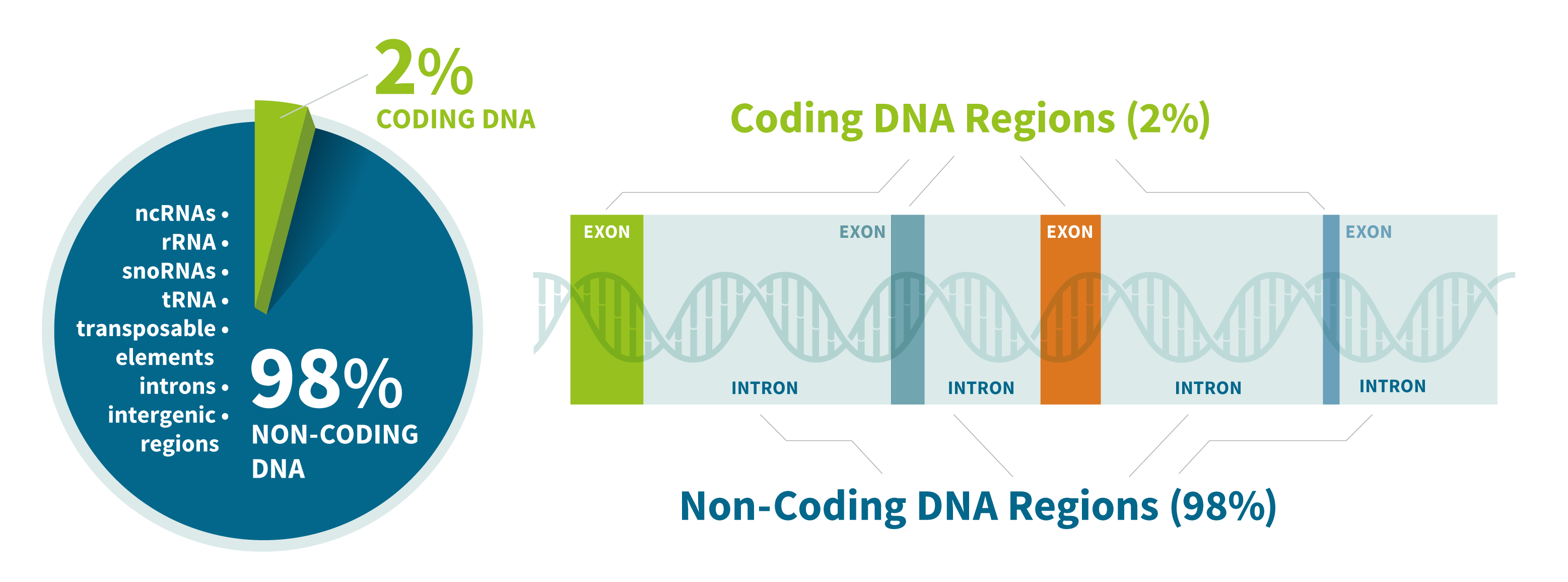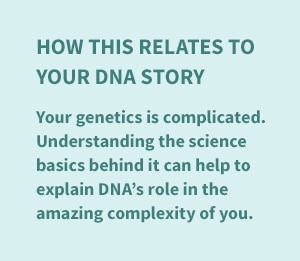Non-Coding DNA
What Is Non-Coding DNA?
Non-coding DNA is a term in genetics to describe DNA that is not a gene or associated with one. Only about 2% of a person’s DNA is made of base pair sequences for genes. What does the other 98% do?

Originally referred to as “junk DNA”—a term derived from a 1972 paper by Dr. Susumu Ohno—the large amount of genomic sequence that does not encode for genes first baffled scientists. For many years after its discovery, it wasn’t clear whether this type of DNA served any purpose. Scientists hypothesized it was mostly the remains of “extinct” genes filling up the human genome.

In the decades since, scientists have learned that non-coding DNA isn’t junk at all. In fact, it plays many critical roles. Specifically, lots of this DNA are now known to be regulatory elements that control gene expression and what forms of a protein are made.
Why Is There Non-Coding DNA in Humans?
Your DNA is the instructions for coordinating the complex functions that make you who you are. Genes are the basic unit of inherited DNA and carry information for making proteins, which perform important functions in your body. But, if only about 2% of your DNA is genes, what is the rest of it doing?
It’s estimated that between 25% and 80% of non-coding DNA regulates gene expression—when, where, and for how long a gene is turned on to make a protein. One way to think about this is to imagine your DNA as a cookbook with recipes for making proteins. The pages with the list of ingredients and measurements are your genes—there are only a few of these pages in the cookbook. The other pages are the recipe instructions, telling you how and in what order to do things.
What about the non-coding DNA that doesn’t regulate gene activity? Some of these are old pieces of DNA, accidentally duplicated a long time ago in evolutionary history and conserved in the DNA since. Others are former genes that have been permanently turned off and no longer work. And some even come from viruses that inserted themselves into the genome a long time ago.
The Function of Non-Coding DNA in Humans
Despite the pejorative “junk DNA,” non-coding DNA in humans is actually very useful. The Encyclopedia of DNA Elements (ENCODE) is one major genetics investigation project that is uncovering many of these functional but non-coding elements. Here are a few examples, along with their various functions.
- Introns: Protein-coding genes are composed of coding regions (exons) separated by non-coding regions (introns). Introns act like spaces between words in a sentence. When the gene is read to make a protein, the introns are cut out of the message and the exons are spliced together.
- Telomeres: These protect the ends of chromosomes from degradation when the DNA is copied as part of DNA replication. Telomeres act like caps on the chromatin at the ends of chromosomes. Because telomeres aren’t fully copied when DNA is replicated, they shorten over a person’s lifetime. Investigators believe telomeres hold clues about aging and certain diseases.
- Satellite DNA: These are highly repetitive sequences of DNA scattered throughout the genome. They are usually composed of a few nucleotides that repeat in tandem for long stretches. They can play an important role in the structure of chromosomes and chromatin.
- Non-coding RNA genes: These DNA elements code for RNA molecules that don't become proteins. RNA molecules can play many important roles, including regulating the expression of other genes.
- Regulatory elements: These DNA sequences control when genes are turned on, for how long, and in what kinds of cells and parts of the body. Common regulatory elements include promoters, enhancers, and silencers. The gene regulation elements contain DNA sequences that act as binding sites for proteins—known as transcription factor binding sites—that control the gene expression.
- Pseudogenes: They may look like normal genes, but they’re not functional and can’t be used to make a protein. Often they form when a gene is duplicated in the DNA during evolutionary history. One copy of the gene is then allowed to accumulate damaging mutations that break it—although sometimes it can evolve a new function. Pseudogenes may regulate the activity of normal genes and share regulatory elements like promoters, enhancers, and silencers.
Can You Activate Non-Coding DNA?
Scientists think so. Lots of non-coding DNA is transcribed into non-coding RNAs or acts as regulatory elements—binding transcription factors and controlling gene activity. Whether the certain non-coding part is active depends on what the cell is doing.
One area that scientists are studying is how to use non-coding DNA to treat cancer. For example, researchers are experimenting with activating transposable elements (TEs), which are DNA sequences that can “jump” and splice themselves into new positions in the DNA. The movement of TEs often stimulates the immune system. So reactivating these non-coding sequences in cancer cells could be a way to get a person’s own immune system to fight the cancer.
References
Hsu, Pu-Sheng, Shu-Han Yu, Yi-Tzang Tsai, Jen-Yun Chang, et al. “More than causing (epi)genomic instability: emerging physiological implications of transposable element modulation.” Journal of Biomedical Science. Accessed August 16, 2022. https://jbiomedsci.biomedcentral.com/articles/10.1186/s12929-021-00754-2.
Kong, Yu, Christopher M. Rose, Ashley A. Cass, Alexander G. Williams, et al. “Transposable element expression in tumors is associated with immune infiltration and increased antigenicity.” Nature Communications. Accessed August 16, 2022. https://www.nature.com/articles/s41467-019-13035-2.
Ohno, Susumu. "So Much ‘Junk’ DNA in Our Genome." Brookhaven Symposium on Biology, Volume 23, 1972: 366-370.